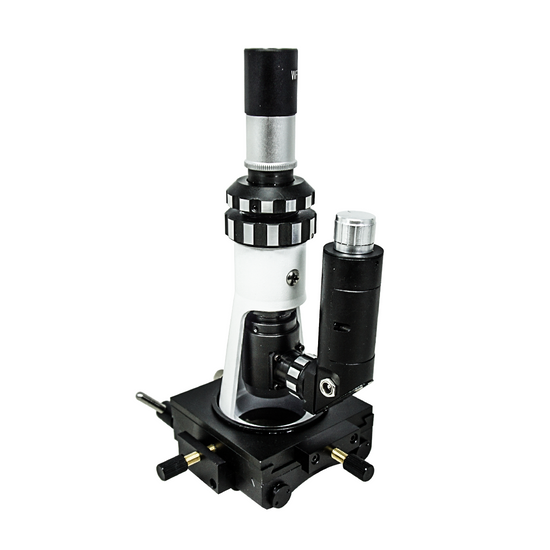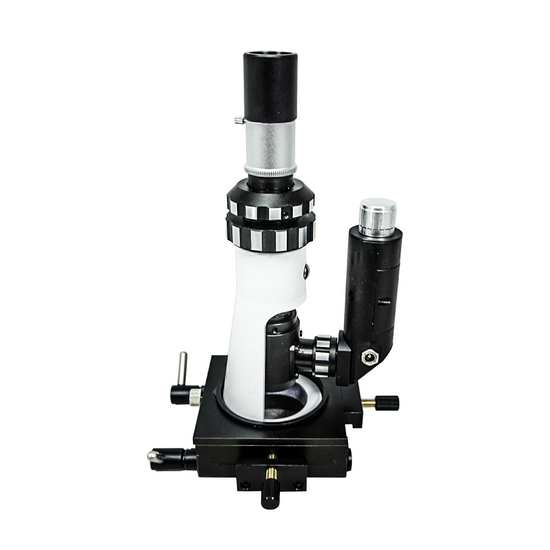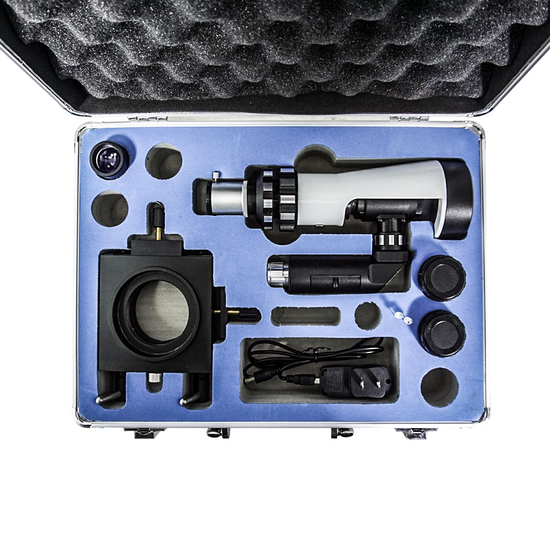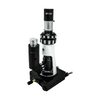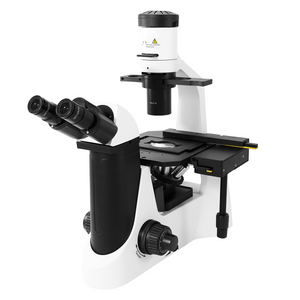Quick Overview
Finite. Total Magnification: 100X/400X. 10X Eyepiece. 10X 40X Achromatic Objective. Eyepiece Field of View: Dia. 18mm. XY Stage Travel Distance: 5.5x15mm. Illumination Type: LED Reflection Light. Top Illumination: Oblique Top Light. Input Voltage: AC 100-240V 50/60Hz. Battery Endurance: 20 hours at full load .
PM02010032 100X/400X Portable Microscope
Optical System Specifications
| Optical System | Finite |
| Mechanical Tube Length | 160mm |
| System Optical Magnification | 100X/400X |
| Expandable System Optical Magnification (Optional Parts Required) | 500X |
| Total Magnification | 100X/400X |
| Standard Eyepiece | 10X Eyepiece |
| Standard Objective | 10X 40X Achromatic Objective |
| System Field of View | Dia. 0.45mm/ Dia. 1.8mm |
| System Working Distance | 0.5mm/7.3mm |
Eyepiece
| 10X Eyepiece ( Dia. 23.2/FN18) | |
| Eyepiece Type | Standard Eyepiece |
| Eyepiece Optical Magnification | 10X |
| Plan Eyepiece | Plan Eyepiece |
| Eyepiece Size for Eye Tube | Dia. 23.2mm |
| Eyepiece Field of View | Dia. 18mm |
| Surface Treatment | Electroplating Black |
| Material | Metal |
| Color | Black |
| Net Weight | 0.04kg (0.09lbs) |
Metallurgical Objective
| 10X Achromatic Objective | |
| Objective Optical System | Finite |
| Objective Optical Magnification | 10X |
| Objective Type | Achromatic Objective |
| Objective Parfocal Distance | 45mm |
| Objective for Mechanical Tube Length | 160mm |
| Objective Working Distance | 10mm |
| Numerical Aperture (N.A.) | N.A. 0.25 |
| Objective Cover Glass Thickness | /- |
| Objective Immersion Media | Dry Objective |
| Objective Screw Thread | RMS Standard (4/5 in. x1/36 in. ) |
| Objective Outer Diameter | Dia. 22mm |
| Surface Treatment | Polished Chrome |
| Material | Metal |
| Color | Silver |
| Net Weight | 0.07kg (0.15lbs) |
| 40X Achromatic Objective | |
| Objective Optical System | Finite |
| Objective Optical Magnification | 40X |
| Objective Type | Achromatic Objective |
| Objective Parfocal Distance | 45mm |
| Objective for Mechanical Tube Length | 160mm |
| Objective Working Distance | 0.5mm |
| Numerical Aperture (N.A.) | N.A. 0.65 |
| Objective Cover Glass Thickness | /0 |
| Objective Immersion Media | Dry Objective |
| Spring Mounted Objective | Spring Mounted objective |
| Objective Screw Thread | RMS Standard (4/5 in. x1/36 in. ) |
| Objective Outer Diameter | Dia. 22mm |
| Surface Treatment | Polished Chrome |
| Material | Metal |
| Color | Silver |
| Net Weight | 0.08kg (0.18lbs) |
Microscope Stand
| Stand Height | 200mm |
| Focus Mode | Manual |
| Focus Distance | 21mm |
XY Mechanical Stage
| Manual Stage | |
| XY Stage Travel Distance | 5.5x15mm |
| XY-Axis Drive Mode | Manual |
| Stage Platform Dimensions | 88x88mm |
| Number of Stage Clips | 1 Pair |
| Surface Treatment | Spray Paint |
| Material | Metal |
| Color | Black |
| Net Weight | 0.85kg (1.87lbs) |
Microscope Illuminator
| Illumination Type | LED Reflection Light |
| Top Illumination | Oblique Top Light |
| Top Illumination Type | LED |
Power Supply
| Input Voltage | AC 100-240V 50/60Hz |
| Output Voltage | DC 5V |
| Power Cord Connector Type | USA 2 Pins |
| Power Cable Length | 0.9m |
| Battery | 16340 Lithium Batteries |
| Battery Endurance | 20 hours at full load |
Other Parameters
| Surface Treatment | Spray Paint |
| Material | Metal |
| Color | White |
| Net Weight | 1.68kg (3.70lbs) |
Series
| PM0201 | PM02010032 |
Technical Info
Instructions
Portable MicroscopeClose Λ
| Portable microscope is the general term for microscopes that are simple in design, easy to carry and convenient for field observation. It usually does not refer to a certain kind of microscope. Portable microscope is simple in design, but also like a microscope, there is at least one eyepiece and one objective lens, or is imaged by a camera, and has a stand and focusing device. Most of them can also be connected to a camera or an eyepiece camera, and then connect the monitor or store digital images. Portable microscope generally adopts hand-held operation, and has simple configuration, fixed working distance, convenient for quick observation. Generally, portable microscope has a light source with a battery, which is convenient to carry to work place and field work, and is suitable for application of various industries and scenarios. |
FiniteClose Λ
| Microscopes and components have two types of optical path design structures. One type is finite optical structural design, in which light passing through the objective lens is directed at the intermediate image plane (located in the front focal plane of the eyepiece) and converges at that point. The finite structure is an integrated design, with a compact structure, and it is a kind of economical microscope. Another type is infinite optical structural design, in which the light between the tube lens after passing the objective lens becomes "parallel light". Within this distance, various kinds of optical components necessary such as beam splitters or optical filters call be added, and at the same time, this kind of design has better imaging results. As the design is modular, it is also called modular microscope. The modular structure facilitates the addition of different imaging and lighting accessories in the middle of the system as required. The main components of infinite and finite, especially objective lens, are usually not interchangeable for use, and even if they can be imaged, the image quality will also have some defects. The separative two-objective lens structure of the dual-light path of stereo microscope (SZ/FS microscope) is also known as Greenough. Parallel optical microscope uses a parallel structure (PZ microscope), which is different from the separative two-object lens structure, and because its objective lens is one and the same, it is therefore also known as the CMO common main objective. |
Mechanical Tube LengthClose Λ
| For objective lens design of finite microscope, its mechanical tube length is the distance from the objective nosepiece shoulder of the objective lens to the eyepiece seat in the tubes, that is, the eyepiece shoulder. There are two standards in the traditional microscope structure, namely, DIN and JIS. DIN (Deutsches Institute fur Normung) is a popular international standard for microscopes, using 195mm standard conjugate distance (also known as object to primary image distance, 36mm objective lens parfocal distance, and 146.5mm optical tube length. JIS (Japanese Industrial Standard) is a standard adopted by some Japanese manufacturers, using 160mm standard conjugate distance (also known as object to primary image distance), 45mm objective lens parfocal distance), and 150mm optical tube length. Using the same microscope standard design, the objective lenses can be used interchangeably. |
System Optical MagnificationClose Λ
| The magnification of the objective lens refers to the lateral magnification, it is the ratio of the image to the real size after the original image is magnified by the instrument. This multiple refers to the length or width of the magnified object. System optical magnification is the product of the eyepiece and the objective lens (objective lens zoom set) of the optical imaging part within the system. Optical magnification = eyepiece multiple X objective lens/objective lens set The maximum optical magnification of the microscope depends on the wavelength of the light to which the object is illuminated. The size of the object that can be observed must be greater than the wavelength of the light. Otherwise, the light cannot be reflected or transmitted, or recognized by the human eye. The shortest wavelength of ultraviolet light is 0.2 microns, so the resolution of the optical microscope in the visible range does not exceed 0.2 microns, or 200 nanometers. This size is converted to the magnification of the microscope, and it is the optical magnification of 2000X. Usually, the compound microscope can achieve 100X objective lens, the eyepiece is 20X, and the magnification can reach 2000X. If it is bigger, it will be called "invalid magnification", that is, the image is large, but the resolution is no longer increased, and no more details and information can be seen. |
Total MagnificationClose Λ
| Total magnification is the magnification of the observed object finally obtained by the instrument. This magnification is often the product of the optical magnification and the electronic magnification. When it is only optically magnified, the total magnification will be the optical magnification. Total magnification = optical magnification X electronic magnification Total magnification = (objective X photo eyepiece) X (display size / camera sensor target ) |
System Field of ViewClose Λ
| Field of View, is also called FOV. The field of view, or FOV, refers to the size of the object plane (i.e., the plane of the point of the observed object perpendicular to the optical axis), or of its conjugate plane (i.e., object to primary image distance), represented by a line value. System field of view is the size of the actual diameter of the image of the terminal display device of the instrument, such as the size of the image in the eyepiece or in the display. Field of view number refers to the diameter of the field diaphragm of the objective lens, or the diameter of the image plane formed by the field diaphragm. Field of view number of objective lens = field of view number of eyepiece / (objective magnification / mechanical tube length) Large field of view makes it easy to observe the full view and more range of the observed object, but the field of view (FOV) is inversely proportional to the magnification and inversely proportional to the resolution, that is, the larger the field of view, the smaller the magnification, and also the lower the resolution of the object to be observed. There are usually two ways to increase the field of view, one is to replace with an objective lens of a smaller multiple, or to replace with an eyepiece of a smaller multiple. |
System Working DistanceClose Λ
| Working distance, also referred to as WD, is usually the vertical distance from the foremost surface end of the objective lens of the microscope to the surface of the observed object. When the working distance or WD is large, the space between the objective lens and the object to be observed is also large, which can facilitate operation and the use of corresponding lighting conditions. In general, system working distance is the working distance of the objective lens. When some other equipment, such as a light source etc., is used below the objective lens, the working distance (i.e., space) will become smaller. Working distance or WD is related to the design of the working distance of the objective lens. Generally speaking, the bigger the magnification of the objective lens, the smaller the working distance. Conversely, the smaller the magnification of the objective lens, the greater the working distance. When it is necessary to change the working distance requirement, it can be realized by changing the magnification of the objective lens. |
Eyepiece Optical MagnificationClose Λ
| Eyepiece optical magnification is the visual magnification of the virtual image after initial imaging through the eyepiece. When the human eye observes through the eyepiece, the ratio of the tangent of the angle of view of the image and the tangent of the angle of view of the human eye when viewing or observing the object directly at the reference viewing distance is usually calculated according to 250 mm/focal length of eyepiece. The standard configuration of a general microscope is a 10X eyepiece. Usually, the magnification of the eyepiece of compound microscope is 5X, 8X, 10X, 12.5X, 16X, 20X. As stereo microscope has a low total magnification, its eyepiece magnification generally does not use 5X, but can achieve 25X, 30X and other much bigger magnification. |
Eyepiece Field of ViewClose Λ
| The eyepiece field of view is the diameter of the field diaphragm of the eyepiece, or the diameter of the image plane of the field diaphragm imaged by the field diaphragm. The diameter of a large field of view can increase the viewing range, and see more detail in the field of view. However, if the field of view is too large, the spherical aberration and distortion around the eyepiece will increase, and the stray light around the field of view will affect the imaging effect. |
Objective Optical MagnificationClose Λ
| The finite objective is the lateral magnification of the primary image formed by the objective at a prescribed distance. Infinite objective is the lateral magnification of the real image produced by the combination of the objective and the tube lens. Infinite objective magnification = tube lens focal length (mm) / objective focal length (mm) Lateral magnification of the image, that is, the ratio of the size of the image to the size of the object. The larger the magnification of the objective, the higher the resolution, the smaller the corresponding field of view, and the shorter the working distance. |
Objective TypeClose Λ
| In the case of polychromatic light imaging, the aberration caused by the light of different wavelengths becomes chromatic aberration. Achromatic aberration is to correct the axial chromatic aberration to the two line spectra (C line, F line); apochromatic aberration is to correct the three line spectra (C line, D line, F line). The objective is designed according to the achromaticity and the flatness of the field of view. It can be divided into the following categories. Achromatic objective: achromatic objective has corrected the chromatic aberration, spherical aberration, and comatic aberration. The chromatic portion of the achromatic objective has corrected only red and green, so when using achromatic objective, yellow-green filters are often used to reduce aberrations. The aberration of the achromatic objective in the center of the field of view is basically corrected, and as its structure is simple, the cost is low, it is commonly used in a microscope. Semi-plan achromatic objective: in addition to meeting the requirements of achromatic objective, the curvature of field and astigmatism of the objective should also be properly corrected. Plan achromatic objective: in addition to meeting the requirements of achromatic objectives, the curvature of field and astigmatism of the objective should also be well corrected. The plan objective provides a very good correction of the image plane curvature in the field of view of the objective, making the entire field of view smooth and easy to observe, especially in measurement it has achieved a more accurate effect. Plan semi-apochromatic objective: in addition to meeting the requirements of plan achromatic objective, it is necessary to well correct the secondary spectrum of the objective (the axial chromatic aberration of the C line and the F line). Plan apochromatic objective: in addition to meeting the requirements of plan achromatic objective, it is necessary to very well correct the tertiary spectrum of the objective (the axial chromatic aberration of the C line, the D line and the F line) and spherochromatic aberration. The apochromatic aberration has corrected the chromatic aberration in the range of red, green and purple (basically the entire visible light), and there is basically no limitation on the imaging effect of the light source. Generally, the apochromatic aberration is used in a high magnification objective. |
Objective Parfocal DistanceClose Λ
| Objective parfocal distance refers to the imaging distance between the objective shoulder and the uncovered object surface (referred to as the “object distance). It conforms to the microscope design, usually 45mm. The objective of different magnifications of the compound microscope has different lengths; when the distance between the objective shoulder and the object distance is the same, the focal length may not be adjusted when converting to objectives of different magnifications. |
Objective for Mechanical Tube LengthClose Λ
| Objective for mechanical tube length is a design parameter of the mechanical tube length of the microscope that the objective is suitable for. |
Objective Working DistanceClose Λ
| The objective working distance is the vertical distance from the foremost surface end of the objective of the microscope to the object surface to be observed. Generally, the greater the magnification, the higher the resolution of the objective, and the smaller the working distance, the smaller the field of view. Conversely, the smaller the magnification, the lower the resolution of the objective, and the greater the working distance, and greater the field of view. High-magnification objectives (such as 80X and 100X objectives) have a very short working distance. Be very careful when focusing for observation. Generally, it is after the objective is in position, the axial limit protection is locked, then the objective is moved away from the direction of the observed object. The relatively greater working distance leaves a relatively large space between the objective and the object to be observed. It is suitable for under microscope operation, and it is also easier to use more illumination methods. The defect is that it may reduce the numerical aperture of the objective, thereby reducing the resolution. |
Numerical Aperture (N.A.)Close Λ
| Numerical aperture, N.A. for short, is the product of the sinusoidal function value of the opening or solid angle of the beam reflected or refracted from the object into the mouth of the objective and the refractive index of the medium between the front lens of the objective and the object. Simply speaking, it is the magnitude of the luminous flux that can be brought in to the mouth of the objective adapter, the closer the objective to the specimen for observation, the greater the solid angle of the beam entering the mouth of the objective adapter, the greater the N.A. value, and the higher the resolution of the objective. When the mouth of the objective adapter is unchanged and the working distance between the objective and the specimen is constant, the refractive index of the medium will be of certain meaning. For example, the refractive index of air is 1, water is 1.33, and cedar oil is 1.515, therefore, when using an aqueous medium or cedar oil, a greater N.A. value can be obtained, thereby improving the resolution of the objective. Formula is: N.A. = refractive index of the medium X sin solid angle of the beam of the object entering the front lens frame of the objective/ 2 Numerical aperture of the objective. Usually, there is a calculation method for the magnification of the microscope. That is, the magnification of the microscope cannot exceed 1000X of the objective. For example, the numerical aperture of a 100X objective is 1.25, when using a 10X eyepiece, the total magnification is 1000X, far below 1.25 X 1000 = 1250X, then the image seen in the eyepiece is relatively clear; if a 20X eyepiece is used, the total magnification will reach 2000X, much higher than 1250X, then eventhoughthe image actually seen by the 20X eyepiece is relatively large, the effect will be relatively poor. |
Objective Cover Glass ThicknessClose Λ
| The thickness of the cover glass affects the parfocal distance of the objective. Usually, in the design of the focal length of the objective,the thickness of the cover glass should be considered, and the standard is 0.17mm. |
Objective Immersion MediaClose Λ
| The use of different media between the objective and the object to be observed is to change and improve the resolution. For example, the refractive index of air is 1, water is 1.33, and cedar oil is 1.515. Therefore, when using an aqueous medium or cedar oil, a greater N.A. value can be obtained, thereby increasing the resolution of the objective. Air medium is called dry objective, where oil is used as medium iscalled oil immersion objective, and water medium is called water immersion objective. However, because of the working distance of the objective, when the working distance of the objective is too long, the use of liquid medium will be relatively more difficult, and it is generally used only on high magnification objective having a shorter working distance, such as objectives of 60X, 80X and 100X. When using oil immersion objective, first add a drop of cedar oil (objective oil) on the cover glass, then adjust the focus (fine adjustment) knob, and carefully observe it from under the side of the objective of the microscope, until the oil immersion objective is immersed in the cedar oil and close to the cover glass of the specimen, then use the eyepiece to observe, and use the fine focus knob to lift the tube until the clear imageof the specimen is clearly seen. The cedar oil should be added in an appropriate amount. After the oil immersion objective is used, it is necessary to use a piece of lens wiping tissue to dip xylene to wipe off the cedar oil, and then wipe dry the lens thoroughly with a lens wiping tissue. |
Spring Mounted ObjectiveClose Λ
| The front end of the objective is equipped with a spring device. When the working distance of the objective is too short, focusing can easily make the objective contact the object to be observed, thereby damaging the object to be observed or the front lens. At this time, the spring acts to recover the front end of the objective lens. It is usually used on high magnification objectives with very short working distances. |
Objective Screw ThreadClose Λ
| For microscopes of different manufacturers and different models, the thread size of their objectives may also be different. In general, the objective threads are available in two standard sizes, allowing similar objectives between different manufacturers to be used interchangeably. One is the British system: RMS type objective thread: 4/5in X 1/36in, One is metric: M25 X 0.75mm thread. |
XY Mechanical StageClose Λ
| There are motion and positioning mechanisms in the XY horizontal direction. In general, the XY stage needs to adjust the level of the stage, so that the stage plane and the main optical axis of the microscope Z direction are perpendicular. |
PackagingClose Λ
| After unpacking, carefully inspect the various random accessories and parts in the package to avoid omissions. In order to save space and ensure safety of components, some components will be placed outside the inner packaging box, so be careful of their inspection. For special packaging, it is generally after opening the box, all packaging boxes, protective foam, plastic bags should be kept for a period of time. If there is a problem during the return period, you can return or exchange the original. After the return period (usually 10-30 days, according to the manufacturer’s Instruction of Terms of Service), these packaging boxes may be disposed of if there is no problem. |
Optical Data
| Microscope Optical Data Sheet | ||||
| P/N | Objective | Objective Working Distance | Eyepiece | |
| PM02012121 (10X Dia. 18mm) | ||||
| Magnification | Field of View(mm) | |||
| PM02012134 | 10X | 10mm | 100X | 1.8mm |
| PM02012136 | 40X | 0.5mm | 400X | 0.45mm |
| PM02012137 | 50X | 0.5mm | 500X | 0.36mm |
| 1. Magnification=Objective Optical Magnification * Body Magnification * Eyepiece Optical Magnification | ||||
| 2. Field of View=Eyepiece Field of View /(Objective Optical Magnification*Body Magnification) | ||||
| 3. The Darker background items are Standard items, the white background items are optional items. | ||||
| Contains | ||||||||||||||||
| Parts Including | ||||||||||||||||
| ||||||||||||||||
| Desiccant Bag | 1 Bag | |||||||||||||||
| Product Instructions/Operation Manual | 1pc | |||||||||||||||
| Packing | |
| Packaging Type | Portable Box |
| Packaging Material | Aluminum Case |
| Packaging Dimensions(1) | 32.5x25x11cm (12.795x9.843x4.331″) |
| Inner Packing Material | Plastic Bag |
| Ancillary Packaging Materials | Styrofoam |
| Gross Weight | 3.14kg (6.92lbs) |
| Minimum Packaging Quantity | 1pc |
| Transportation Carton | Carton Packaging |
| Transportation Carton Material | Corrugated Carton |
| Transportation Carton Dimensions(1) | 37x30x16cm (14.567x11.811x6.299″) |
| Total Gross Weight of Transportation(kilogram) | 3.14 |
| Total Gross Weight of Transportation(pound) | 6.92 |
| Quantity of One Transportation Carton | 1pc |
 |


